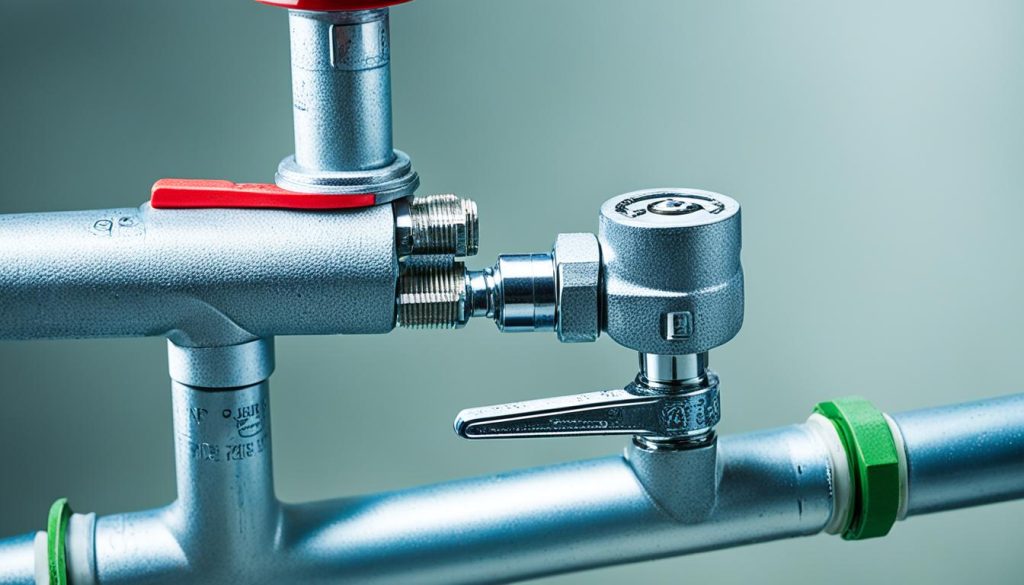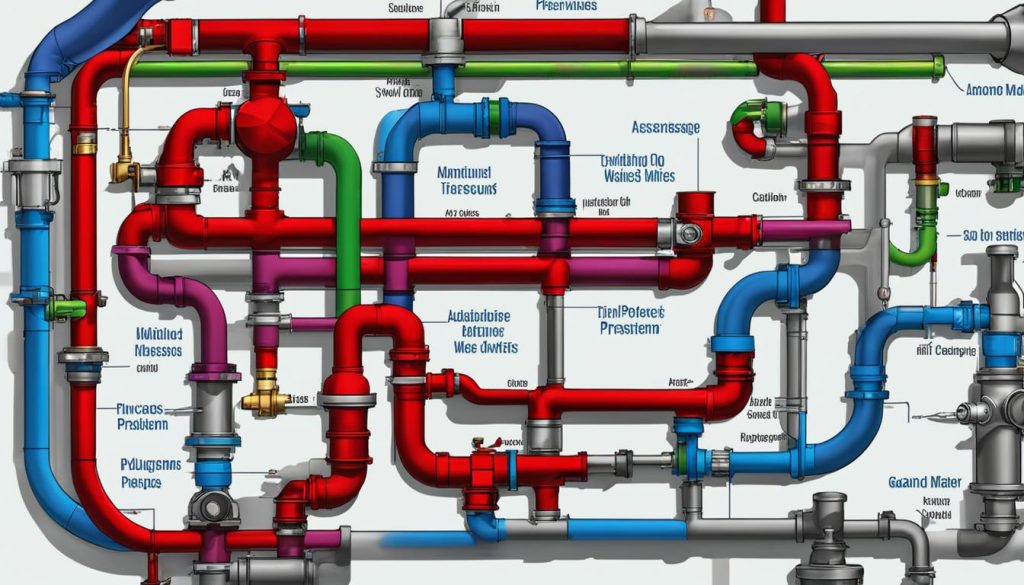Solving Negative Pressure in Plumbing Easily
Did you know that negative pressure in plumbing vents can lead to blockages and interruptions in water flow?
A working plumbing vent is essential for maintaining the proper function of a home’s plumbing system. Plumbing vents, also known as vent stacks, play a crucial role in regulating the pressure in drainage pipes. They filter out gases and allow fresh air to enter, preventing foul odors and ensuring effective drainage.
However, when negative pressure occurs in plumbing vents, it can cause various problems, including standing water in sinks or bathtubs, slow drains, and gurgling noises.
Key Takeaways:
- Negative pressure in plumbing vents can cause blockages and interruptions in water flow.
- Indications of vent blockage include standing water, slow drains, and gurgling noises.
- To fix the issue, try clearing drains with an auger or plunger and accessing the plumbing vent on the roof to remove any debris.
Possible Issues with Plumbing Vents
Blockages in plumbing vents can be a major culprit behind low water pressure and interrupted water flow in your plumbing system. If left unattended, these blockages can also lead to the formation of sediment, which can cause further damage to your pipes. To identify if you have a vent blockage, keep an eye out for signs such as standing water, slow drains, and gurgling noises coming from your fixtures. Once you’ve determined a blockage is likely the issue, it’s time to take action.
Clearing a vent blockage involves accessing the plumbing vent on your roof and removing any debris that may be causing the obstruction. However, sometimes the blockage may not be immediately visible. In such cases, using a hose or an auger can help dislodge and clear the obstruction effectively. It’s crucial to ensure that the blockage is completely removed to restore proper water pressure and prevent any further damage that could result in costly repairs down the line.
In case you’re uncertain about how to handle the blockage or if you’re wary of climbing on your roof, it’s always best to consult with a professional plumber who can diagnose and address the issue with their expertise. Remember, resolving plumbing vent blockages promptly is key to maintaining a fully functional and efficient plumbing system in your home.
Importance of Managing Air Pressure in Drainage Systems
Efficient drainage system design involves carefully managing the mix of air and water to maintain the water seal in traps and prevent foul odors and bacterial contamination. This is especially crucial in high-rise and commercial buildings with complex pipework networks.
When water flows suddenly, it can create positive pressure in front and negative pressure behind, potentially causing issues within the plumbing system. Negative pressure can lead to trap failure and the release of sewer gases, while positive pressure can result in foul air passing through trap seals.
To resolve these issues and ensure a well-functioning drainage system, various solutions are available for controlling air pressure:
- Secondary Ventilation: By installing a secondary “dry” pipe alongside the main stack, pressure imbalances can be balanced, and the entry of sewer gases into the building can be prevented.
- Stack-Aerators: These devices replace T-branch fittings and control the speed of falling waste water, merging flows with the main stack to control the mix of water and pressure.
- Active Drainage Ventilation: Systems like the Studor P.A.P.A actively manage pressure fluctuations and provide relief at the Point of Need. These systems work in tandem with air admittance valves to stabilize pressure levels and maintain trap seals.
Implementing these solutions helps balance pressures, stabilize trap seals, and protect occupants from unpleasant odors and contamination.
| Pressure Issue | Effect | Solution |
|---|---|---|
| Negative Pressure | Trap failure and release of sewer gases | Implement secondary ventilation |
| Positive Pressure | Foul air passing through trap seals | Use stack-aerators to control pressure |
| Pressure Fluctuations | Frequent challenges in high-rise buildings | Utilize active drainage ventilation systems |
Controlling Air Pressure in Drainage Systems
When it comes to managing air pressure in drainage systems, there are several effective solutions that can help resolve low pressure issues and troubleshoot negative pressure in pipes. Let’s explore some of these plumbing solutions:
Secondary Ventilation
One solution is to install a secondary ‘dry’ pipe alongside the main stack. This secondary ventilation system helps balance pressures within the plumbing system and prevents the entry of sewer gases into the building. By providing an additional path for air to escape, secondary ventilation ensures that pressure fluctuations do not hinder the proper functioning of the drainage system.
Stack-Aerators
Stack-aerators are another effective option for controlling air pressure in drainage systems. These devices replace T-branch fittings and work to reduce the speed of falling wastewater. By merging flows with the main stack, stack-aerators effectively control the mix of water and pressure, ensuring a stable and efficient drainage process.
Active Drainage Ventilation Systems
For a more advanced solution, consider using active drainage ventilation systems like the Studor P.A.P.A. These systems actively control pressure levels and provide relief at the Point of Need. By working in conjunction with air admittance valves, they stabilize pressure levels within the drainage system and maintain trap seals, ensuring optimal performance.
Marley Plumbing & Drainage offers a range of ventilation products, including the Maxi-Vent and Mini-Vent, designed to provide complete ventilation systems for controlling and stabilizing pressure within drainage systems. With these reliable solutions, you can effectively manage air pressure and ensure the smooth operation of your plumbing system.
Importance of Proper Pressure Management in Drainage Systems
Correctly managing pressure within a drainage system is crucial for its efficient operation and the health and well-being of occupants. In high-rise buildings, simultaneous usage of plumbing fixtures can cause pressure fluctuations, resulting in both positive and negative pressures. These pressure imbalances can lead to various issues such as trap failure, foul odors, and the release of sewer gases.
To address these problems, it is essential to implement effective pressure management solutions. Secondary ventilation, stack-aerators, and active drainage ventilation systems are some viable options. Secondary ventilation involves installing a secondary “dry” pipe alongside the main stack to balance pressures and prevent sewer gases from entering the building.
Stack-aerators replace T-branch fittings, reducing the speed of falling waste water and merging flows with the main stack, thus controlling the mix of water and pressure. Additionally, active drainage ventilation systems, like the Studor P.A.P.A, actively regulate pressure and provide relief at the Point of Need. These systems work in conjunction with air admittance valves to stabilize pressure levels and maintain trap seals, effectively preventing odors and contamination.
Proper pressure management not only ensures the smooth functioning of drainage systems but also protects the occupants of the building. By controlling and stabilizing pressure levels, maintaining trap seals, and preventing odors and contamination, these pressure management solutions contribute to a healthier and more comfortable living environment.
- Investing Wisely: How Windows & Doors in Boost Property Value and Financial Health - April 24, 2025
- The Financial Impact of Personal Injuries: Why Legal Help Matters for Business Owners - April 16, 2025
- The Hidden Financial Costs of Domestic Assault: What Business Owners Need to Know - April 16, 2025













